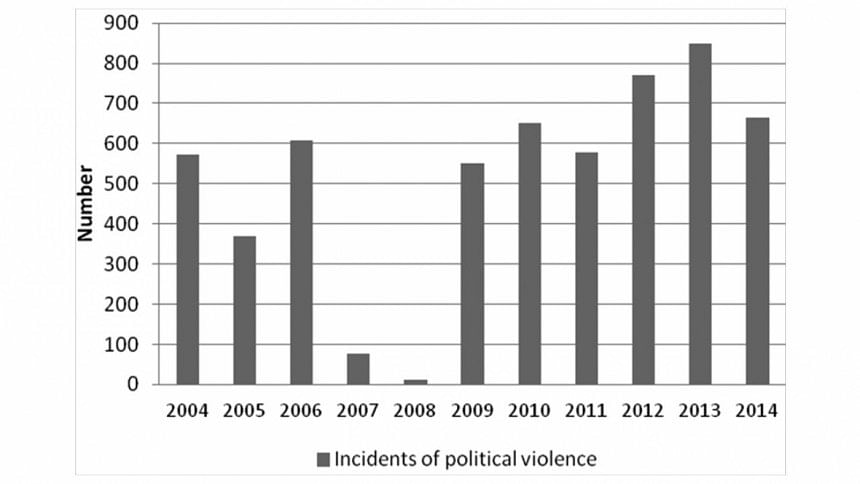Trends and patterns

Political violence remains inseparable from Bangladeshi politics and election violence is an integral part of that violence. The recent UP election is not an exception. Till now, 10 people have reportedly died while more than a thousand people were wounded in the first phase of the Union Parishad election held in 2016.
To varying degrees, political violence has been a concern for Bangladesh practically since independence. More disconcerting, it seems not to have abated since the restoration of democracy in 1991, and in recent years, has only escalated further. On January 16, 2015, the spokesperson for the Office of the High Commissioner for Human Rights (OHCHR), at a press briefing in Geneva, remarked that "the deepening political violence in Bangladesh.....is very disturbing." In March 2015, an article headlined "Bangladesh paralysed by violence as scores die in political war" was published in the online version of The Daily Telegraph. Academic and activist writings on the issue suggest that, in the course of time, violence, introduced as an 'instrument' by political parties to exercise power over the opposition, eventually became 'institutionalised as the political norm.' Evidence from many countries indicates that ruling party-instigated violence can be backed by government authorities, while opposition-induced violence appears to be more difficult to understand, especially when it is widespread, indiscriminate and extreme in nature. That in Bangladesh political violence, regardless of who initiates it, has become inseparable from the political culture in the country which practices democracy is a matter of serious concern.
Data on violence clearly shows that there has been an upward trend in the number of incidents over a long period. The intensity and severity of violence has also increased. The political parties now employ more sophisticated weapons, and in doing so, affect more people than before. Let us consider the evidence. Research undertaken at the BRAC Institute of Governance and Development (BIGD, BRAC University), based on print media sources, reported 2,500 incidents of violence from 1991 to 2001. The number of such incidents increased to 2,800 from 2001 to 2006, and changed little (2,700) from 2008 to 2013 across all 64 districts of Bangladesh.
Moving to the number of deaths and injuries from these incidents reveals two staggering findings. From 2001-2006, overall political violence claimed 1,500 lives and resulted in 37,000 injuries. In the subsequent five years, more than 500 people died and about 34,000 were injured. And, the number of deaths and injuries were higher in 2006-2013 when compared to the previous years.
While interparty conflicts are expected (although, breaking out into serious violence is not), conflicts within party factions are also common. The same data shows that 20 percent of the total violence was a result of internecine factional conflicts within the political parties during the 1990s. This has risen in recent years. From 2008-2012, 37 percent of the total reported incidents of violence took place between party factions. Interestingly, irrespective of the regime, the ruling party consistently accounted for the larger share of total factional violence. This could well suggest that factional violence is related to struggles over control of resources. Boucek (2009) argued that when there is an excessive focus on factional interest in the party, it might reflect "weakness of the party as an institution," promoting "rent seeking" behaviour and shifting focus away from the party's collective interest. He termed this as a "degenerative" form of factionalism.
Looking at the data, it is evident that politically induced violence peaks before the period preceding the election years or during that time. This was evident from 2006 and 2013. The situation became even worse after the January 5, 2014 national elections. Fifteen people were killed in 'gun fights' between January 1 and January 27, 2014. Similar incidents occurred during the local government elections, including pourashava, city corporation, municipal, upazila and union parishad elections. There were several incidents of violence resulting in death, injuries, vandalism, arson and bomb blasts in the aftermath of the Upazila Parishad elections of 2014. The recent first-ever partisan municipal election in 2015 also witnessed violence, vote-rigging and intimidation, which were widely covered by the media. Newspapers reported that people were killed, polling stations were captured, and fraudulent voting took place during these elections.
Electoral violence is a threat to democratic institutions. While the Election Commission and law enforcement agencies assure the public of peaceful conditions during the elections, it has proven difficult for them to achieve their professed objective. A significant test in this regard would be for the authorities to learn from the severity of the recent UP election, and not just intend to take "appropriate measures to ensure free and fair polls" but also ensure that the outcome is achieved.
The writers are researchers at BRAC Institute of Governance and Development (BIGD), BRAC University.

 For all latest news, follow The Daily Star's Google News channel.
For all latest news, follow The Daily Star's Google News channel. 







Comments